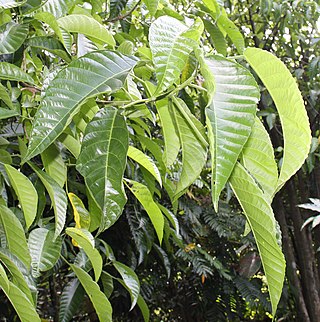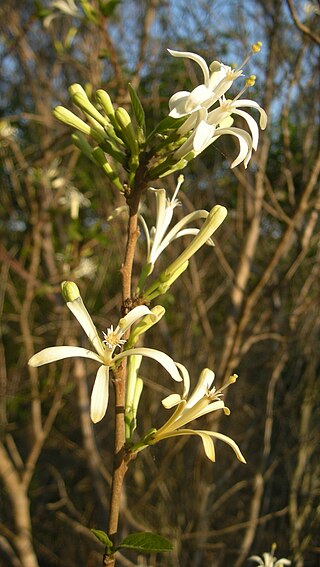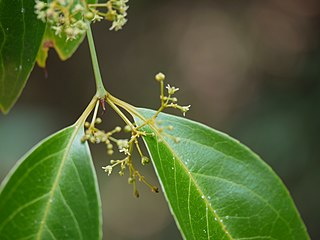
Antidesma is a genus of tropical plant in the family Phyllanthaceae formally described by Linnaeus in 1753. It is native to tropical Africa, S + E + SE Asia, Australia, and various oceanic islands. The greatest diversity occurs in Southeast Asia.

Mallotus is a genus of the spurge family Euphorbiaceae first described as a genus in 1790. Two species are found in tropical Africa and Madagascar. All the other species are found in East Asia, the Indian Subcontinent, Southeast Asia, eastern Australia, and certain islands of the western Pacific. The genus has about 150 species of dioecious trees or shrubs.

Joseph Marie Henry Alfred Perrier de la Bâthie was a French botanist who specialized in the plants of Madagascar.

Dendrocnide is a genus of approximately 40 species of plants in the nettle family Urticaceae. They have a wide distribution across North East India, Southeast Asia, Australia and the Pacific Islands. In Australia they are commonly known as stinging trees.

Turraea is a genus of plants in the family Meliaceae, native throughout of Old World Tropics. In the countries of Angola, Australia, Benin, Botswana, Burundi, Cambodia, Cameroon, Central African Republic, China, Comoros, Congo, Equatorial Guinea, Eritrea, Eswatini, Ethiopia, Gabon, Ghana, Gulf of Guinea Islands, Indonesia Ivory Coast, Kenya, Laos, Liberia, Madagascar, Malawi, Mauritius, Mozambique, Namibia, Nigeria, Papua New Guinea, Philippines, Rwanda, Réunion, Saudi Arabia, Sierra Leone, Somalia, South Africa, Sudan, Tanzania, Thailand, Togo, Uganda, Vietnam, Yemen, Zambia and Zimbabwe.

Didymoplexis, commonly known as crystal orchids or as 双唇兰属 , is a genus of terrestrial leafless orchids in the family Orchidaceae, about twenty species of which have been described. Orchids in this genus have swollen, fleshy rhizomes and thin, pale, upright fleshy flowering stems with resupinate, bell-shaped white or pale yellowish brown flowers. They are native to Africa, Madagascar, Southeast Asia, Australia and various islands of the Pacific.
Dichrocephala is a genus of flowering plants in the family Asteraceae, native to tropical Africa and southern Asia.
Leptaspis is a genus of Paleotropical plants in the grass family, native to Africa, southern Asia, northern Australia, and a few islands of the western Pacific.

Anisomeles is a genus of herbs of the family Lamiaceae and is native to China, the Indian Subcontinent, Southeast Asia, New Guinea, Australia, Madagascar, and some Pacific and Indian Ocean islands. Plants in the genus Anisomeles have small, flat, narrow elliptic to narrow e.g.-shaped leaves arranged in opposite pairs, the edges of the leaves sometimes wavy or serrated. The flowers are arranged in groups, with five sepals and five petals in two "lips", the lower lip with three lobes, the middle lobe much longer than the side lobes. There are four stamens that extend beyond the petals and a single style in a depression on top of the ovary. The fruit is a schizocarp with four nutlets containing small seeds.

Dillenia alata, commonly known as red beech, golden guinea flower or golden guinea tree, is a tree in the Dilleniaceae family, found in tropical forests of the Moluccas, New Guinea, and northern Australia.
Pieter van Royen (1923-2002) was a Dutch botanist. He is an author of many papers on the flora of New Guinea.

Reissantia is a genus of flowering plants belonging to the family Celastraceae.

Loeseneriella is a genus of flowering plants belonging to the family Celastraceae.

Girardinia is a genus of flowering plants belonging to the family Urticaceae.
Lagrezia is a genus of flowering plants belonging to the family Amaranthaceae. It is also within the Amaranthoideae subfamily.
Levieria is a genus of flowering plants belonging to the family Monimiaceae. They are dioecious trees or shrubs.
Donella is a genus of flowering plants belonging to the family Sapotaceae.
Gambeya is a genus of flowering plants belonging to the family Sapotaceae.
Rousseauxia is a genus of flowering plants belonging to the family Melastomataceae.

Huberia is a genus of flowering plants belonging to the family Melastomataceae.











